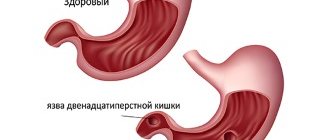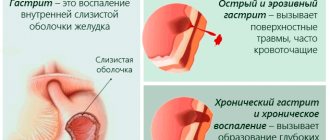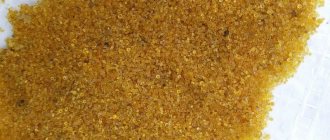What it is?
Stomach acidity is an indicator that characterizes the amount of hydrogen ions in the lumen of the organ. Its values are most influenced by hydrochloric acid, which is produced by the parietal cells of the mucous membrane. In addition, gastric juice contains bicarbonates, water, and various enzymes. They, as well as food or drink, can change the acidity of the stomach.
Help The unit of measurement throughout the world is the hydrogen index (pH). The acidity of pure water at a temperature of 25°C was chosen as the standard, which is 7.0. When it increases, the indicator drops to zero, and when it decreases, it increases to 15.
Acidity plays an important biological role. Due to the high concentration of hydrochloric acid, pathogenic bacteria that enter the digestive tract along with food are killed. Also, under conditions of high acidity, pepsin is activated , an enzyme that takes part in the breakdown of proteins. In addition, its fluctuations affect the functional activity of the pancreas and the motility of the digestive tract.
Norm
The acidity level differs in different parts of the stomach in a healthy person. This is due to the fact that parietal cells, which produce hydrochloric acid, are located mainly in the area of the body and bottom of the organ. And most of the secretory cells that produce bicarbonates and mucus are located immediately before the entrance to the duodenum.
There are also age differences. In newborns, acidity significantly reduced , which is due to the nature of their nutrition and the low activity of parietal cells. Starting from the first days of life, it gradually increases, and already at 3-4 months it reaches adult levels.
Standard indicators of acidity in various parts of the stomach are collected in the following table:
| Index | Norm, pH |
| Gastric lumen on an empty stomach in adults (basal acidity) | 1,5-2 |
| Antrum | 1,6-7,3 |
| Vault | 1,0-4,6 |
| Back wall | 1-1,8 |
| Front wall | 0,9-1,4 |
| Deep in the epithelial layer | 5,8-7,7 |
| The lumen of the body of the stomach on an empty stomach in newborns | 4,2-6,6 |
Deviation from the norm has many negative consequences for the patient:
- increased risk of developing an inflammatory process or a defect in the mucous membrane of the stomach or duodenum;
- disruption of the functioning of stomach enzymes (pepsin, lipase), which slows down the digestion process;
- increased or decreased motility of the digestive tract;
- increased risk of developing intestinal infections and food poisoning;
- changes in the functioning of the pancreas.
How to determine the acidity level
Normal indicators of the level of gastric juice secretion are considered to be pH values from 1.5 to 2, the maximum value is 0.86 pH, the minimum is 8.3 pH. In different parts of the stomach, the indicators are also different - in the antrum the norm corresponds to values of 1.3-7.4 pH, in the epithelial layer - 7.0 pH.
To determine the level of gastric juice secretion, intragastric pH-metry is performed; this is a method for determining its level directly in the gastrointestinal tract. This study is carried out using acidogastrometer devices, which have probes and sensors.
The research conducted may be of the following types:
- express assessment – within 20 minutes;
- short-term – last several hours;
- daily – the acid level is assessed during the day;
- endoscopic (fibrogastroduodenoscopy - FGDS) - carried out during endoscopic examination;
- aspiration - the contents are taken in the hospital using a fractional probe and examined.
Using the table of values, the doctor compares the secretion readings obtained with those indicated and makes appropriate conclusions about acidity (normal - within normal limits, weak (low), zero (at a critical level), high (hyperacidity), etc.). Although gastric secretion may change throughout life and depends on various factors, its indicators must correspond to the maximum permissible standards.
You can find out about the presence of reduced secretion yourself at home without performing a gastroscopy. You need to be more attentive to the signals given by your body. For example, frequent constipation, belching with an unpleasant odor, flatulence. The disadvantage of this method is its inaccuracy. But such signs should be a reason to consult a doctor. These signs should.
What affects the pH of gastric juice?
The following factors can increase it:
- irregular or unbalanced diet;
- smoking;
- gastritis;
- presence of Helicobacter pylori infection;
- gastrinoma (benign tumor of the pancreas);
- frequent stressful situations ;
- excessive activation of the parasympathetic nervous system;
- long-term use of certain groups of medications (non-steroidal anti-inflammatory drugs, glucocorticoids);
- severe concomitant diseases or injuries that require hospitalization in the intensive care unit.
A decrease in acidity occurs due to the following factors:
- autoimmune damage to parietal cells;
- long-term malnutrition (cachexia);
- gastritis;
- presence of Helicobacter pylori infection;
- radiation therapy for malignant tumors;
- decreased thyroid function (hypothyroidism);
- cardiovascular pathologies, atherosclerotic changes in the arteries of the stomach;
- portal hypertension (increased pressure in the portal vein system due to chronic liver diseases);
- long-term use of antibiotics , cytostatics, hormonal anti-inflammatory drugs.
Symptoms
An increase or decrease in acidity is accompanied by various symptoms of digestive disorders. Their severity is more pronounced in childhood and young age. In elderly patients, detecting them is quite problematic:
| Symptoms of increased acidity | Symptoms of low acidity |
|
|
How to check PH?
There are various methods for determining pH levels. Some of them are widely used in clinical practice and have become the diagnostic standard for gastric diseases, others have experimental value or low information content.
Gastroscopy (FGDS)
FGDS is considered the gold standard for diagnosing gastric pathologies. To carry it out, it is necessary to insert a special probe (endoscope) through the mouth or nose . The procedure is done under local anesthesia of the posterior wall of the oropharynx, sedation or general anesthesia.
At the end of the endoscope there is a sensor that measures the acidity of the environment in real time. The received data is transmitted to the screen.
Please note: FGDS makes it possible to measure not only
the acidity of gastric juice in various areas of the stomach , but also in the esophagus , as well as the acidity of intestinal juice in the duodenum .
The study is carried out on an empty stomach, so basal acidity is measured. In addition, the doctor has the opportunity to visually assess the condition of the gastric mucosa, and, if necessary, conduct a biopsy followed by cytological examination in the laboratory.
Help The price for determining acidity is on average 300 rubles. and is an additional analysis to gastroscopy. In order not to swallow the probe twice and to choose the most effective treatment for gastritis, we recommend that you definitely add this analysis when paying for an FGDS.
Acidotest
This research technique allows you to approximately estimate the acidity of the stomach without inserting a probe. It is used in practice if there are contraindications to FGDS (for example, recent myocardial infarction). But its accuracy is quite low, which significantly reduces the value of the Acidotest results.
The patient drinks 2 tablets of caffeine on an empty stomach, which is a stimulant of gastric secretion. Then he gives the first portion of urine, after which he is given 3 tablets of the drug to drink. They contain a resin that, when reacted with hydrochloric acid, forms a dye. It gets into the urine and turns it scarlet. Its intensity is compared with a special color scale , which allows you to assess the acidity of the environment in the stomach.
Acidotest
Blood analysis
Assessing the concentration of gastrin and pepsinogen in the blood allows us to approximately assess the severity of gastric secretion. Their amount in the blood is directly dependent on the level of acidity. The norm for gastrin 17 is 3-25 pmol/l, and for pepsinogen – 30-150 µg/l.
The disadvantage of the analysis is its lack of accuracy , which is often not enough to determine treatment tactics. However, laboratory blood tests to assess gastric acidity remain a promising area that many research centers are working on.
Litmus test strip
An indirect method for assessing acidity by measuring it on the tongue. There is evidence that the pH values of the stomach and oral cavity are interrelated. In the oral cavity, it should normally remain in the range of 6.6-7.4 , which corresponds to a neutral environment.
Before the procedure, it is advisable not to eat for 1.5 hours . To evaluate, take 1 litmus strip and place it on the upper surface of the tongue for a few seconds. With increased acidity, the litmus color will appear orange, and with low acidity, it will turn green or blue.
Important The accuracy of the study is low. Therefore, doctors do not recommend using it in diagnosis.
Determination at home
There are several other methods for roughly assessing stomach acidity at home. However, their information content remains quite low.
Diagnostics
Gastric acidity is best determined in a hospital or diagnostic center.
Today, there are 3 methods for determining the level of acidity of gastric juice:
- Intragastric pH-metry. The study is carried out using special medical devices equipped with probes with pH sensors that measure the level of acidity. The technique allows you to simultaneously conduct research in several areas of the gastrointestinal tract. Depending on the goals, urgency and condition of the patient, 4 subtypes of diagnostics are distinguished: express method, the study is carried out within 20 minutes;
- daily diagnostics;
- short-term study carried out over several hours;
- endoscopic, to be performed during FEGSD.
- Fractional intubation of the stomach. Gastric juice is tested in the laboratory, after suction using a rubber tube. The technique most often gives distorted results due to the mixing of juice from different parts of the stomach during the suction period;
- Acidotest. The technique is a non-invasive method; the level of acidity is determined by the degree of coloration of the urine. Allows you to determine the secretory activity of the stomach using uropepsin. Diagnostics are used as additional ones, since the results are not always accurate.
Interesting! Function, composition and properties of gastric juice - how it is formed
Self-diagnosis test
Using a short questionnaire, you can preliminarily determine the type of gastric acid disorder at home.
The first group of questions includes:
- Do you experience burning pain in your stomach or chest after eating?
- Do you experience heartburn after fatty, spicy or sour foods?
- Are you prone to constipation?
- Do you feel heaviness in your upper abdomen after eating?
- Is burping sour?
If the patient says “yes” to most of the answers, then he most likely has increased acidity.
The second group also consists of 5 questions:
- Do you feel quickly full while eating?
- Does burping have an unpleasant or putrid odor?
- Do you experience periodic aching abdominal pain, regardless of food intake?
- Are you prone to diarrhea or flatulence?
- Can nausea occur on an empty stomach?
If the answers to most of these questions are positive, the patient most likely has low acidity.
Methods for determining stomach acidity at home
You can independently find out the acidity of the stomach at home, focusing on internal sensations, using a pharmacy test or certain foods:
According to internal signs and sensations
How to find out the acidity of the stomach at home will be indicated by symptoms indicating a violation of the digestive process. When the amount of HCL is low, fermentation occurs in the intestines. The food eaten does not have time to be digested and accumulates, provoking the appearance of bacteria that affect the gastrointestinal tract.
Signs indicating the development of low acidity include:
- Change in taste sensations. There is a previously uncharacteristic desire to consume foods containing ascorbic acid.
- The appearance of belching with a rotten smell.
- Flatulence caused by fermentation processes. The occurrence of gas is accompanied by cramps in the lower abdomen.
- Discomfort in the diaphragmatic area.
- Pain after eating.
- Diarrhea resulting from the ingestion of gastrointestinal microbes.
- Acne.
- Dry skin.
- Hair splitting, nails peeling.
- Weakening of the immune system due to the constant opposition of the leukocyte system to toxic substances accumulating in the body.
The large amount of acid produced by the cells is characterized by pain caused by the release of HCL into the esophagus.
An increase in the percentage of hydrogen chloride causes:
- Discomfort and burning behind the sternum, neutralized by drugs, milk, baking soda.
- A metallic taste appears in the mouth.
- The occurrence of hunger cramps is a reaction to the lack of food. Most often, an unpleasant symptom appears in the morning (it is eliminated with the consumption of any amount of food).
- Sour belching.
- Coating of the tongue with a yellowish coating with gray patches.
- Afternoon diarrhea.
- Headache with dizziness.
Using litmus paper
A pharmacist will tell you how to find out the acidity of the stomach at home, suggesting using a text based on litmus. A pharmacy instrument helps characterize the components that make up the digestive juice using paper colored with an indicator (lichen squeeze). Subacidity is determined in accordance with the scale drawn on the package with the test.
The most reliable way to find out the acidity of the stomach is with the help of indicator strips.
To determine the level of stomach acidity, litmus paper must be applied to the tongue and left in this position for 1-2 seconds.
The color of the indicator determines the saturation of hydrochloric acid:
- purple tint means normal;
- red, pink proves the development of increased acidity;
- blue indicates alkaline composition (low acidity).
Test rules:
- The study is carried out in the morning (from 10:00 to 12:00). During this period, the content of hydrogen chloride in the body increases and salivation slows down. In the evening, significantly less HCL is produced.
- Before the test, you should refrain from eating for at least 2 hours.
- On the day of the test, you should not consume acidic foods, carbonated drinks, or fruit juices. You are allowed to drink only water that does not contain gas.
The litmus test is not 100% guaranteed.
Its effectiveness is influenced by:
- previously eaten foods;
- salivation rate;
- internal features of the body.
For a more accurate result, it is necessary to carry out the analysis 3-4 days in a row at the same time. The diagnosis is made after studying the summary data for the entire study period.
Using millet porridge
How to find out the acidity of the stomach at home is indicated by some food products, the consumption of which provokes an active reaction in the body.
Subacidity can be easily determined by eating warm millet porridge with the addition of butter fat. People suffering from high acidity levels complain of severe heartburn after consuming this dish.
With lemon
Citrus fruits contain vitamin C. Patients with low acidity enjoy eating lemons. After eating the fruit (with a lack of hydrogen chloride), a pleasant aftertaste appears. If there is high acidity, a person cannot eat a slice of lemon. Ascorbic acid will cause discomfort, heartburn, and belching.
Using natural apple juice
The test using freshly squeezed apple juice should be done before breakfast. During the study, a hungry patient drinks 200 ml of the drink.
Test performance:
- the occurrence of spasms and pain in the peri-umbilical region, radiating to the sternum, indicates an increased level of acidity;
- absence of unpleasant symptoms - indicates normal acid-base metabolism;
- the emerging desire to drink another glass of juice is characterized by the predominance of alkaline salts and metals in the composition of gastric juice.
Using other products
Sodium bicarbonate (baking soda) (1/2 tsp) dissolved in drinking water (200 ml) is taken on an empty stomach (preferably in the morning). In people with normal acidity, the drink will cause belching. If the consumption of the mixture went well, then the patient will experience a reduced level of acidity.
First aid
To quickly reduce stomach acidity, the patient is advised to drink a glass of still alkaline mineral water . As an alternative, you can use antacids (Almagel, Maalox, Rennie, Phosphalugel). These drugs neutralize hydrochloric acid in the lumen of the stomach, which quickly normalizes acidity and relieves the patient of unpleasant symptoms. You can check out our rating of antacids.
Popular antacids
For effective therapy it is necessary to establish the cause of the pathology . If Helicobacter pylori infection , then antibacterial therapy with 2-3 drugs is required. In other cases, the use of proton pump inhibitors (omeprazole, pantoprazole, rabeprazole) is sufficient. They allow you to reduce the secretion of hydrochloric acid for 18-24 hours after administration.
In case of reduced acidity, replacement therapy with hydrochloric acid preparations, as well as pepsinogen, shows effectiveness. antispasmodics helps relieve pain and discomfort . But at the same time, it is necessary to carry out a thorough diagnosis and treatment of the causes in the near future, since such patients have an increased risk of developing stomach cancer.
Signs and treatment of high stomach acidity
Specific symptoms and signs of high acidity in the stomach can also be determined independently.
The most characteristic clinical sign of increased secretion is heartburn, which appears after the release of hydrochloric acid into the esophagus.
The provoking factor of digestive upset, as a rule, is foods that are harmful to the stomach with high acidity:
- various food additives and spices;
- citrus juices.
How to determine increased stomach acidity? First of all, you need to drink a glass of alkaline mineral water or a weak soda solution. If you feel better and the main symptomatic sign has disappeared, then you can safely talk about a clinical problem in the digestive system. Patients often complain of nausea and vomiting at the mere thought of foods that cause stomach discomfort.
Drinking a glass of warm water on an empty stomach activates the stomach.
You should entrust the treatment of your problem to professionals. Having determined the cause-and-effect relationship, the gastroenterologist will prescribe the necessary set of therapeutic procedures that will significantly improve the situation. On the part of the patient, one should only strictly follow the doctor’s dietary recommendations and take medications on time.











